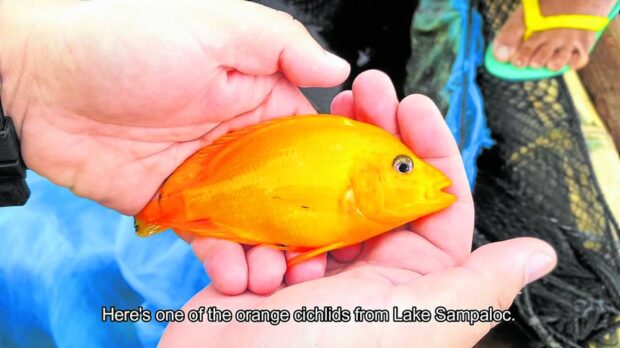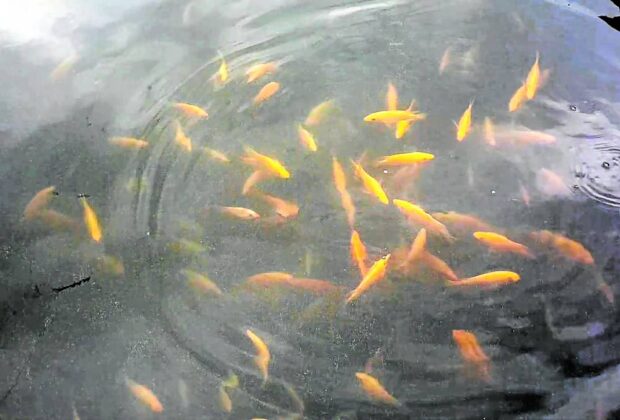All that glittery fish isn’t gold for San Pablo’s Sampaloc Lake

EYE-CATCHING ALIEN | There’s “gold” in Lake Sampaloc, but it’s not necessarily a welcome find for fish pen owners. Bright orange fish known as “flowerhorns” — originally from Central America and usually kept in aquariums — pose a threat as an invasive species that could decimate the local tilapia population. (Photo by GREGG YAN / Contributor)
MANILA, Philippines — For almost a decade now, Lake Sampaloc in San Pablo, Laguna province, has been host to a growing golden horde.
But it’s a glistening sight that comes at a great ecological cost.
Jepolo Austria used to raise only Nile tilapia (Oreochromis niloticus) and bighead carp (Hypophthalmichthys nobilis) in his fish pens, but now he also harvests and sells a more colorful catch.
“They are perfect for ponds because they look a bit like koi,” said Austria, or Mang Puloy to his neighbors. “We call them ‘flowerhorns’ and they were introduced here sometime in 2015.” He said he would sell them for P100 per kilo if they were to be eaten, or P5 apiece if to be kept as pets.
“But I hope these golden newcomers do not affect my tilapia farm too much,” he told this writer.
Article continues after this advertisement
(Photo by GREGG YAN / Contributor)
‘Midas’ threat
Flowerhorns are hybrid cichlids that are popularly kept in aquariums because of their visual appeal and interesting behavior. Cichlids (pronounced “sick-lids”) refer to a large family of freshwater fish whose members range from the colorful mbuna (pronounced “em-buna”) found in Lake Malawi (in the landlocked country of Malawi in South Africa) to the tasty tilapia that are raised in the Philippines.
Article continues after this advertisementUntil verified through further studies, the flowerhorns in Lake Sampaloc are believed to be Midas cichlids (Amphilophus citrinellus) which are native to tropical and Central America, particularly in Costa Rica and Nicaragua.
Highly aggressive, they can grow about a foot in length and develop a prominent “nuchal hump,” a ball-like organ on their forehead. Although a source of delight for tourists and additional income for the likes of Mang Puloy, they have spread unchecked as an invasive species in lakes and waterways around the world, from the United States to Singapore.
“Having Midas cichlids in our local lakes poses a threat to our economically important native or indigenous fish species, since cichlids are omnivorous and can feed on the larvae and juveniles of native fish species,” said Dr. Maria Rowena Eguia, an associate professorial lecturer at De La Salle University who has been studying aquaculture for the past 40 years.
Omnivorous
“The Asean [region] is rich in freshwater biodiversity [thanks to] a number of inland lakes whose unique geological history allows them to support species and subspecies endemic to these water bodies. Introducing alien species into these closed systems will greatly impact the native species in those lakes,” said Dr. Mundita Lim, executive director of the Asean Center for Biodiversity. (Asean stands for the Association of Southeast Asian Nations.)
“Tilapia and the infamous knife fish, for instance, are predators which can devour endemic fish species to extinction. Other invasive alien fish such as janitorfish can compete with local species for food and space, thus eventually displacing them,” Lim added.
The tilapia is one example of an invasive species that eventually became economically useful and is now commonly farmed. But a more recent invader like the flowerhorn cichlid can feed on the larvae and juveniles of tilapia, potentially affecting the livelihood of local raisers, Eguia said.
Down to 3 natives
Lake Sampaloc is the largest of San Pablo’s famed Seven Crater Lakes, which are all interconnected. Experts now fear that the golden Midas cichlids can eventually spread to the other six lakes.
In 2014, the Seven Crater Lakes system was classified by the Global Nature Fund as “threatened” because of pollution and the dwindling native fish population.
In a study conducted by Jonathan Briones and fellow researchers in February 2016, nine of a dozen fish species recorded in Lake Sampaloc were found to be invasive. There were only three native fish species remaining—two types of “biya” or goby and the endangered “ayungin.”
Providing a bigger picture, a paper published by AG Cagauan in November 2008 showed that over 170 foreign fish species had been introduced to the Philippines in the past century.
The Midas cichlids are just the latest in a long line of finned invaders like the clown knife fish (Chitala ornata), janitorfish (Pterygoplichtys and Hypostomus spp.) and the various tilapia species that now dominate most Philippine lakes and rivers.
In enclosed bodies of water like Laguna de Bay and Taal Lake, the native “maliputo” (Caranx ignobilis) and “tawilis” (Sardinella tawilis) are facing such threats.
“With more and more invasive fish prowling our freshwater ecosystems, we are gradually depriving ourselves of the diversity of our indigenous nutritional sources and gourmet options,” Lim said.
To help stop the spread of invasive fish, a 2019 study by Jennifer Poniente and fellow researchers recommended various interventions to contain the problem. Among the potential solutions are tighter controls on the pet trade, especially in the propagation and sale of ornamental fish.
* * *
The author is the executive director of Best Alternatives, a nonprofit established in 2014 that promotes sustainable and ethical alternatives to practices and technologies that can harm the environment.